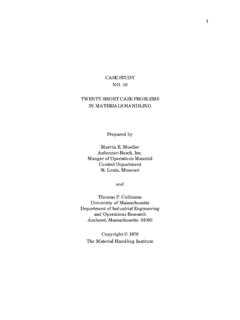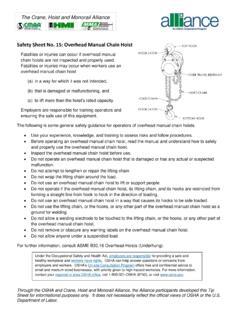Transcription of Ten Principles for - MHI
1 The Ten Principles of Material handling The Key to Greater Productivity, Customer Service, and Profitability For Further Information on the Material handling Institute Please Contact or Write: Material handling Institute 8720 Red Oak Blvd., Suite 201. Charlotte, NC 28217-3992. Phone: 704-676-1190. Fax: 704-676-1199. out sacrificing needed flexibility , modular- PLANNING PRINCIPLE. 1 All material handling should be the result of a deliberate plan where the ity and of changing future requirements needs, performance objectives and func- Definition: Standardization means less tional specification of the proposed meth- variety and customization in the methods ods are completely defined at the outset.
2 And equipment employed. Definition: A plan is a prescribed course KEY POINTS: of action that is defined in advance of implementation. In its simplest form a The planner should select methods and material handing plan defines the mate- equipment that can perform a variety of tasks rial (what) and the moves (when and under a variety of operating conditionsand in where); together they define the method Standardization applies to sizes of (how and who). containers and other load forming components as well as operating procedures and equip- ment. KEY POINTS: Standardization, flexibility and modu- larity must not be incompatible.
3 The plan should be developed in consultation between theplanner(s) and all who will use and benefit from the equipment to be employed. Success in planning large scale material handling projects generally requires a team 3 WORK PRINCIPLE. Material handling work should be minimized without sacrificing pro- approach involving suppliers, consultants when ductivity or the level of service required of appropriate, and end user specialists from the operation. management, engineering, computer and information systems, finance and operations. Definition: The measure of work is The material handling plan should material handling flow (volume, weight or reflect the strategic objectives of the organiza- count per unit of time) multiplied by the tion as well as the more immediate needs.
4 Distance moved. The plan should document existing methods and problems, physical and eco- nomic constraints, and future requirements KEY POINTS: and goals. The plan should promote concurrent Simplifying processes by reducing, engineering of product, process design, combining, shortening or eliminating unnec- process layout, and material handling meth- essary moves will reduce work. ods, as opposed to independent and sequential Consider each pickup and set-down, or design practices. placing material in and out of storage, as distinct moves and components of the distance moved. Process methods, operation sequences and 2 SP TANDARDIZATION.
5 RINCIPLE. process/equipment layouts should be prepared that support the work minimization objective. Where possible, gravity should be used Material handling methods, equip- to move materials or to assist in their move- ment, controls and software should ment while respecting consideration of safety be standardized within the limits of achiev- and the potential for product damage. ing overall performance objectives and with- The shortest distance between two points is a straight line 4 ERGONOMIC. PRINCIPLE. of manufacturing and the resulting distribu- tion channels. Large unit loads are common both pre and post manufacturing in the form of raw Human capabilities and limitations materials and finished goods.
6 Must be recognized and respected in the de- During manufacturing, smaller unit sign of material handling tasks and equip- loads, including as few as one item, yield less ment to ensure safe and effective operations. in-process inventory and shorter item through- put times. Smaller unit loads are consistent with Definition: Ergonomics is the science manufacturing strategies that embrace that seeks to adapt work or working operating objectives such as flexibility, conditions to suit the abilities of the continuous flow and just-in-time delivery. worker. Unit loads composed of a mix of different items are consistent with just-in-time KEY POINTS: and/or customized supply strategies so long as item selectivity is not compromised.
7 Equipment should be selected that eliminates repetitive and strenuous manual labor and which effectively interacts with SPACE UTILIZATION. human operators and users. The ergonomic principle embraces both physical and mental tasks. 6 PRINCIPLE. The material handling workplace and Effective and efficient use must be the equipment employed to assist in that work made of all available space. must be designed so they are safe for people Definition: Space in material handling is three dimensional and therefore is counted as cubic space. UNIT LOAD PRINCIPLE. 5 Unit loads shall be appropriately sized and configured in a way which KEY POINTS: achieves the material flow and inventory ob- In work areas, cluttered and unorga- jectives at each stage in the supply chain.
8 Nized spaces and blocked aisles should be eliminated. Definition: A unit load is one that can In storage areas, the objective of be stored or moved as a single entity at maximizing storage density must be balanced against accessibility and selectivity. one time, such as a pallet, container or When transporting loads within a tote, regardless of the number of indi- facility the use of overhead space should be vidual items that make up the load. considered as an option. KEY POINTS: Less effort and work is required to collect and move many individual items as a single load than to move many items one at a time. Load size and composition may change as material and product moves through stages KEY POINTS: 7 SYSTEM PRINCIPLE.
9 Material movement and storage activities should be fully integrated Pre-existing processes and methods should be simplified and/or re-engineered to form a coordinated, operational system before any efforts at installing mechanized or which spans receiving, inspection, storage, automated systems. production, assembly, packaging, unitizing, Computerized material handling order selection, shipping, transportation and systems should be considered where appropri- the handling of returns. ate for effective integration of material flow and information management. Definition: A system is a collection of Treat all interface issues as critical to interacting and/or interdependent entities successful automation, including equipment to that form a unified whole.
10 Equipment, equipment to load, equipment to operator, and control communications. KEY POINTS: All items expected to be handled automatically must have features that accom- modate mechanized and automated handling . Systems integration should encompass the entire supply chain including reverse logistics. It should include suppliers, manu- ENVIRONMENTAL. facturers, distributors and customers. Inventory levels should be minimized at all stages of production and distribution while 9 PRINCIPLE. respecting considerations of process variabil- Environmental impact and en- ity and customer service. ergy consumption should be considered as Information flow and physical material criteria when designing or selecting alter- flow should be integrated and treated as native equipment and material handling sys- concurrent activities Methods should be provided for easily tems.











